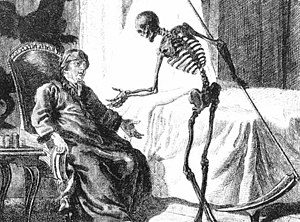Tod
| Tod | |
|---|---|
| File:God of Death.jpg Artist depiction of Tod. | |
| God of Death, Disease, Judgement, the Grim Reaper, and Prince of Hölle. | |
| Abode | The Underworld, Wondering. |
| Symbol | Skeletons, skull, scythes, black robes, red eyes, decaying plants/vegetables/fruit, Crows. |
| Parent(s) | Hölle |
| Siblings | Seuche, Schwarz Yak, Schatten |
| Children | N/A |
| Translation | Tod comes from the German word for 'death' and 'decease'. Tod has also gone by the name 'Sterben', which also means death; the names of 'Vernichtung', 'Todesfall', and 'Ende' have also been associated with Tod -- Grim Reaper being one of them as well. |
| Affiliation | Engel Generation, Three Princes of Hölle |
| Mantra | "Death is one shade of the other -- dark and light. His scythe judges those who are guilty and his hand guides the soul to the afterlife. Disease and destruction lay in his wake if civilization makes the greatest mistake." |
| Weapon | Tod's 'Sense' (Scythe) or sometimes referred to the 'Mähen'(Mow or to reap). |
Tod, who is often called 'Sterben' as well, is the Commoner personification of Death, Pestilence, and Psychopomp in TECT Mythology. He is also referred to as 'Vernichtung' (destruction), 'Todesfall' (death), and 'Ende' (end); he is best known for his popular modern associated name as the Grim Reaper. Tod, in TECT Mythology, is the Angel of Death, Pestilence, Judgement, and Destruction; his role of keeping the balance of the world by reaping those who escape death, guiding those who die to the afterlife, and punishing civilization for its heresy has often made him a dark figure. In many works however, Tod is described as intervening to stop death of those who do not deserve it and protecting innocents who do not deserve suffering. Tod is also a Prince of Hell, son to Hölle, the spreader of pestilence in the world, and the final judgement of who dies or lives; often played as "The figure of the Dark and the Light."
In most artworks, pottery, and literature; Tod is described as a tall skeletal figure wrapped in a robe that's black on the outside and red inside. His skeleton feet are bird like talons, sharp enough to slash and strong enough carry off anyone, and his skull is often referred to a Yak's (believed to be inherited from his mother, the Black Yak) skull with two bony horns. His bony tail is connected to the top half of his scythe with a long red string of charms; a belt of charms which is said to hold each disease known to man. Tod also has large black feathered wings that protrude large red eyes along the top section; eyes that watch and judge all mortal life. It is often hard to tell the gender of Tod based on artwork and descriptions in ancient literature; most believe Tod is male based on the use of 'he' in literature -- some think however the term is used for ease or a translation mistaken in modern times.
Tod's main role in TECT Mythology is to keep balance in the world through maintaining his basic duties; reaping, guiding, and punishing. Scholars have a viewpoint that Tod can, or could have, been able to change nature itself; leading to fates such as Sisyphus, who tricked the Greek equivalent, Thanatos, into trapping himself -- or, those destined to die could tempt or bribe for their lives. In his primary duty; Tod acts as a psychopomp, or to escort newly deceased souls to the afterlife. In a minor duty however, Tod punishes man usually by death or reaping of the souls; his duty of spreading disease is often intertwined with his role of punishment. Tod has shown interest in man though in order to see if destiny can be changed, or, if Tod personally wished to change fate, did so. These known duties have often labeled Tod as a corrupt deity, a destroyer of civilization, and the guiding hand to the deceased.
